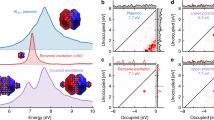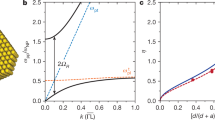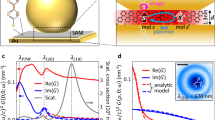Abstract
Photon emitters placed in an optical cavity experience an environment that changes how they are coupled to the surrounding light field. In the weak-coupling regime, the extraction of light from the emitter is enhanced. But more profound effects emerge when single-emitter strong coupling occurs: mixed states are produced that are part light, part matter1,2, forming building blocks for quantum information systems and for ultralow-power switches and lasers3,4,5,6. Such cavity quantum electrodynamics has until now been the preserve of low temperatures and complicated fabrication methods, compromising its use5,7,8. Here, by scaling the cavity volume to less than 40 cubic nanometres and using host–guest chemistry to align one to ten protectively isolated methylene-blue molecules, we reach the strong-coupling regime at room temperature and in ambient conditions. Dispersion curves from more than 50 such plasmonic nanocavities display characteristic light–matter mixing, with Rabi frequencies of 300 millielectronvolts for ten methylene-blue molecules, decreasing to 90 millielectronvolts for single molecules—matching quantitative models. Statistical analysis of vibrational spectroscopy time series and dark-field scattering spectra provides evidence of single-molecule strong coupling. This dressing of molecules with light can modify photochemistry, opening up the exploration of complex natural processes such as photosynthesis9 and the possibility of manipulating chemical bonds10.
This is a preview of subscription content, access via your institution
Access options
Subscribe to this journal
Receive 51 print issues and online access
$199.00 per year
only $3.90 per issue
Buy this article
- Purchase on Springer Link
- Instant access to full article PDF
Prices may be subject to local taxes which are calculated during checkout




Similar content being viewed by others
References
Tame, M. S. et al. Quantum plasmonics. Nature Phys. 9, 329–340 (2013)
Koenderink, A. F., Alù, A. & Polman, A. Nanophotonics: shrinking light-based technology. Science 348, 516–521 (2015)
Sato, Y. et al. Strong coupling between distant photonic nanocavities and its dynamic control. Nature Photon. 6, 56–61 (2012)
Liu, X. et al. Strong light–matter coupling in two-dimensional atomic crystals. Nature Photon. 9, 30–34 (2015)
Yoshie, T. et al. Vacuum Rabi splitting with a single quantum dot in a photonic crystal nanocavity. Nature 432, 200–203 (2004)
Thompson, J. D. et al. Coupling a single trapped atom to a nanoscale optical cavity. Science 340, 1202–1205 (2013)
Faraon, A. et al. Coherent generation of non-classical light on a chip via photon-induced tunnelling and blockade. Nature Phys. 4, 859–863 (2008)
Gröblacher, S. et al. An experimental test of non-local realism. Nature 446, 871–875 (2007)
Coles, D. M. et al. Strong coupling between chlorosomes of photosynthetic bacteria and a confined optical cavity mode. Nature Commun. 5, 5561 (2014)
Shalabney, A. et al. Coherent coupling of molecular resonators with a microcavity mode. Nature Commun. 6, 5981 (2015)
Törmä, P. & Barnes, W. L. Strong coupling between surface plasmon polaritons and emitters: a review. Rep. Prog. Phys. 78, 013901 (2015)
Novotny, L. & Hecht, B. Principles of Nano-Optics (Cambridge Univ. Press, 2006)
Zengin, G. et al. Realizing strong light-matter interactions between single-nanoparticle plasmons and molecular excitons at ambient conditions. Phys. Rev. Lett. 114, 157401 (2015)
Zengin, G. et al. Approaching the strong coupling limit in single plasmonic nanorods interacting with J-aggregates. Sci. Rep. 3, 3074 (2013)
Schlather, A. E., Large, N., Urban, A. S., Nordlander, P. & Halas, N. J. Near-field mediated plexcitonic coupling and giant Rabi splitting in individual metallic dimers. Nano Lett. 13, 3281–3286 (2013)
Ciracì, C. et al. Probing the ultimate limits of plasmonic enhancement. Science 337, 1072–1074 (2012)
de Nijs, B. et al. Unfolding the contents of sub-nm plasmonic gaps using normalising plasmon resonance spectroscopy. Faraday Discuss. 178, 185–193 (2015)
Benz, F. et al. Nanooptics of molecular-shunted plasmonic nanojunctions. Nano Lett. 15, 669–674 (2015)
Kasera, S., Herrmann, L. O., del Barrio, J., Baumberg, J. J. & Scherman, O. A. Quantitative multiplexing with nano-self-assemblies in SERS. Sci. Rep. 4, 6785 (2014)
Netzer, F. P. & Ramsey, M. G. Structure and orientation of organic molecules on metal surfaces. Crit. Rev. Solid State Mater. Sci. 17, 397–475 (1992)
Vahala, K. J. Optical microcavities. Nature 424, 839–846 (2003)
Khitrova, G., Gibbs, H. M., Kira, M., Koch, S. W. & Scherer, A. Vacuum Rabi splitting in semiconductors. Nature Phys. 2, 81–90 (2006)
Patil, K., Pawar, R. & Talap, P. Self-aggregation of methylene blue in aqueous medium and aqueous solutions of Bu4NBr and urea. Phys. Chem. Chem. Phys. 2, 4313–4317 (2000)
Akselrod, G. M. et al. Probing the mechanisms of large Purcell enhancement in plasmonic nanoantennas. Nature Photon. 8, 835–840 (2014)
Anger, P., Bharadwaj, P. & Novotny, L. Enhancement and quenching of single-molecule fluorescence. Phys. Rev. Lett. 96, 113002 (2006)
Kinkhabwala, A. et al. Large single-molecule fluorescence enhancements produced by a bowtie nanoantenna. Nature Photon. 3, 654–657 (2009)
Kravtsov, V., Berweger, S., Atkin, J. M. & Raschke, M. B. Control of plasmon emission and dynamics at the transition from classical to quantum coupling. Nano Lett. 14, 5270–5275 (2014)
Hutchison, J. A., Schwartz, T., Genet, C., Devaux, E. & Ebbesen, T. W. Modifying chemical landscapes by coupling to vacuum fields. Angew. Chem. Int. Ed. 51, 1592–1596 (2012)
Galego, J., Garcia-Vidal, F. J. & Feist, J. Cavity-induced modifications of molecular structure in the strong coupling regime. Phys. Rev. X 5, 041022 (2015)
Feist, J. & Garcia-Vidal, F. J. Extraordinary exciton conductance induced by strong coupling. Phys. Rev. Lett. 114, 196402 (2015)
Acknowledgements
We acknowledge financial support from the UK’s Engineering and Physical Sciences Research Council (grants EP/G060649/1, EP/N020669/1, EP/L027151/1 and EP/I012060/1) and the European Research Council (grant LINASS 320503). This study was partially supported by the Air Force Office of Scientific Research (AFOSR); the European Office of Aerospace Research and Development (EOARD) is also acknowledged. R.C. acknowledges support from the Dr. Manmohan Singh scholarship from St John’s College, University of Cambridge. F.B. acknowledges support from the Winton Programme for the Physics of Sustainability. S.J.B. acknowledges support from the European Commission for a Marie Curie Fellowship (NANOSPHERE, 658360).
Author information
Authors and Affiliations
Contributions
J.J.B. and R.C. conceived and designed the experiments. R.C. performed the experiments with input from F.B. and B.d.N. R.C. and A.D. carried out the simulation and the analytical modelling with input from J.J.B., P.F., O.H. and E.R. R.C. and J.J.B. analysed the data. S.J.B. and O.A.S. synthesized cucurbit[n]uril and provided input on the fabrication and characterization of samples. R.C. and J.J.B. wrote the manuscript with input from all authors.
Corresponding author
Ethics declarations
Competing interests
The authors declare no competing financial interests.
Additional information
Data supporting this paper are available at https://www.repository.cam.ac.uk/handle/1810/254579.
Supplementary information
Supplementary Information
This file contains Supplementary Methods, Text and Data, Supplementary Figures 1-20 and additional references. (PDF 2361 kb)
Rights and permissions
About this article
Cite this article
Chikkaraddy, R., de Nijs, B., Benz, F. et al. Single-molecule strong coupling at room temperature in plasmonic nanocavities. Nature 535, 127–130 (2016). https://doi.org/10.1038/nature17974
Received:
Accepted:
Published:
Issue Date:
DOI: https://doi.org/10.1038/nature17974
This article is cited by
-
Synthesized complex-frequency excitation for ultrasensitive molecular sensing
eLight (2024)
-
All-in-one, all-optical logic gates using liquid metal plasmon nonlinearity
Nature Communications (2024)
-
Dynamical control of nanoscale light-matter interactions in low-dimensional quantum materials
Light: Science & Applications (2024)
-
Quantum plasmonics pushes chiral sensing limit to single molecules: a paradigm for chiral biodetections
Nature Communications (2024)
-
Light–matter interactions in quantum nanophotonic devices
Nature Reviews Physics (2024)
Comments
By submitting a comment you agree to abide by our Terms and Community Guidelines. If you find something abusive or that does not comply with our terms or guidelines please flag it as inappropriate.



